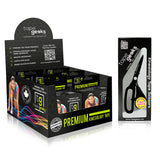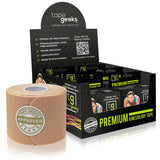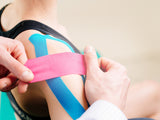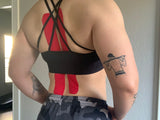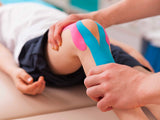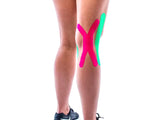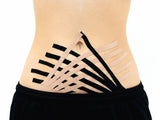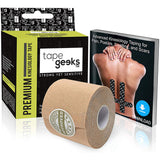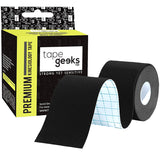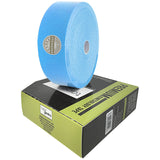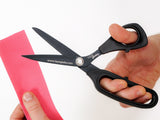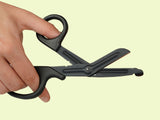Contents
- Definition of Kinesiology Tape Terms
- What is kinesiology tape?
- How does kinesiology tape work?
- What does kinesiology tape do?
- How do you apply kinesiology tape?
- Can you be allergic to kinesiology tape?
- How to cut kinesiology tape?
- Where do you apply Kinesio tape?
- How do I choose Kinesio tape?
- What makes Tape Geeks different from other brands?
- How to Remove Kinesiology Tape
- What is a cohesive bandage used for?
- What are the benefits of using cohesive bandage?
- Kinesiology Taping Scissors
Definition of Terms
Anchor - is the beginning of the application strip. It should have 0% tension.
Ends or Tails - is the tail-end of the tape. It should have 0% tension.
Base - is the middle part of the tape between the anchor and the ends. It is also considered the therapeutic area of the tape.
Tails - is/are the split for the Y, X, and fan kinesiology tape cuts
What is kinesiology tape?
Developed in the 1970s by Dr. Kenzo Kase, a Japanese chiropractor, kinesiology tapes are designed to deliver muscle support without limiting movement. Sported by professional athletes on their back, knees, shoulders, and abs, these tapes come in all sorts of vivid, bright, and eye-catching colors. They’re widely popular among physical therapists and even regular folks to help alleviate muscle pain and discomfort while boosting muscle support, even aiding recovery.
Kinesiology tapes are made from a combination of cotton, spandex, and adhesive. Designed to mimic the elasticity of the skin, they are also stretchier than the usual athletic tapes.
Water-resistant, kinesiology tapes stay on the skin even when you are sweating. You can even leave them on when showering!

How does kinesiology taping work?
Kinesiology tapes work by lifting the skin from the muscle below. In turn, the tape reduces swelling and promotes blood flow to the muscle to increase its function.
Grayson Wickham, a Physical Therapist, explains, “When [the] tape is applied, it causes compression or decompression of these areas, supposedly allowing it to alter pain signals to the brain.”
What are the benefits of kinesiology taping?
Kinesiology tape is designed to alleviate pain as it lifts the skin off the area of injury. Several studies have since looked into the other benefits of taping. Its benefits include the reduction of swelling and inflammation, improved fluid circulation, support for injured muscles, among several others.
Check out this article to learn the many benefits that you can get from kinesiology taping.
If you’re a professional though, I’m pretty sure that you already know these things. Sign up with a professional Tape Geeks account today and get your 40% OFF FOR LIFE!
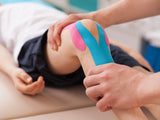
What are the things that you need to remember when applying kinesiology tape?
Before starting your tape application, here are a few things that you need to keep in mind:
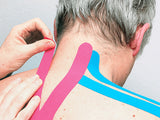
- Always measure the tape, the patient in a lengthened position or an ideal postural position.
- Always round your tape ends.
- Always remove a portion of the paper backing to create a tab rather than removing the entire paper backing before a taping application.
- Always finish as much tape as possible on the skin rather than on tape.
- Always ensure that the tape ends of both your compression and security strips are applied with 0% tension. This will allow the tape to stick and avoid skin irritation leading to longevity in your tape applications.
Want to know more about kinesiology taping? Here’s an article that you can check out on some of the things to take note of if you’re new to kinesiology taping.
What happens if you get a rash?
If you’re developing a rash from applying kinesiology tape, well, don’t worry! We have a few tricks up our sleeves to make sure that you won’t experience it again.
Firstly, be wary of inexpensive tapes. Oftentimes these tapes skimp out on their materials, sacrificing quality. Oftentimes, they make use of cheap elements that can be harsh for your skin. Second, if possible, opt for tapes with gentler adhesives. Additionally, make sure that your skin is clean before applying the tape. Do not put any lotions or oils prior to application.
Want to know more? Here are a few more things to keep in mind to prevent kinesiology tape rash.
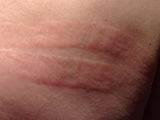
What are the different types of kinesiology tape cuts?
Different areas of the body need different types of taping applications. So, here are the different kinesio tape cuts:

Kinesiology Taping Protocols for Different Areas of the Body
Shoulder
Commonly caused by overuse and misuse, the pain felt in the shoulder joint can be preventable. Kinesiology taping is a great way to improve one’s sense of movement. Follow the video demonstration above to help with shoulder pain.
Want to know more? Read more about shoulder pain here.
Elbow
Pain in the elbow is commonly experienced not just by athletes, but also by painters, butchers, carpenters, plumbers. It is commonly caused by doing repetitive motions in the wrist and the arm. Follow this protocol to help with elbow pain.
Check out our article about elbow pain to know about it.
Knee
Numerous therapists and athletes have turned to kinesiology tape to relieve pain while getting support for their knees. Some even use tapes to prevent injury. Try the protocol in the video to help with your knee pain.
Ankle
Ankle injuries are one of the most common injuries in the lower body. An inversion sprain or rolling of the foot inward is perhaps the most prevalent one. Try our ankle taping protocol if you’re currently experiencing pain in your ankle.
How do you choose which type of kinesiology tape is right for you?
Different types of kinesiology tape rolls:
Depending on what your needs are and how often you use kinesiology tapes, you can choose among pre-cut, uncut standard rolls, and bulk kinesiology tape rolls. Here are the benefits that each option brings.

What makes Tape Geeks different from other brands?
If you’re not familiar with our brand, we make good on the promise of delivering kinesiology tapes that stick without making your skin sick. Meaning, we use high-quality materials to ensure your skin is safe while using our tape.
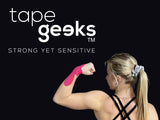
When you use Tape Geeks products, here are some things that you can expect:
Strong. Built to last, Tape Geeks sports tapes are sticky and will stay put as you wear them through rigorous workouts. You don’t even have to worry about sweat or going to the shower while wearing our adhesives - they will stay on! While the tape is strong, it will stick to the skin without peeling off on removal!
Sensitive. For folks with sensitive skin, extinguish your worries about developing skin problems with our athletic kinesiology tapes. Dermatologist Factory approved, our tapes are hypoallergenic and are proven to leave NO rashes or marks after use!
High-Grade. Bringing you only the best of the best, Tape Geeks tapes are ISO-factory approved. Our medical sports tapes have 100% high-quality adhesives with consistent and reliable quality.
If you’ve tried us out and decided that we haven’t lived up to your expectations, note that we do offer a lifetime warranty, and we are more than happy to give you a full refund if you are not satisfied with your purchase.
If you’re looking to start your taping journey today, let me point you in the right direction.

Shop our collection now
Shop NowHow do you painlessly remove Kinesiology tape?
1. Prepare baby oil or cooking oil.
2. Dab a good amount on the tape and leave it on for 15 - 20 minutes.
3. Remove and gently pull the tape in the direction of the area’s hair growth.
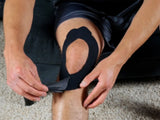
Other types of sports tape
There are a slew of different athletic tapes in the market today that bring different benefits not just for athletes, but also a handful of folks that experience injury and pain. Arguably as popular as kinesiology tapes, are cohesive bandages.
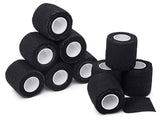
Cohesive bandage
What is cohesive bandage?
Perfect for binding limbs without having a wax-style removal after, cohesive bandage is designed to bring support for different joint injuries. Taking note of the name, it adheres to itself only.
What are the benefits of using cohesive bandage?
Do not stick to skin and hair. Get joint support while doing away with (sometimes) painful removal of athletic tape. As cohesive tape only adheres to itself, it’ll be easy enough to remove but still secure enough to stay in place.
Flexibility. Being able to stretch twice its unstretched length, you can adjust this tape’s tension with ease. Vary your level of support depending on the need, ranging from light support with no stretch to extra support by upping the tension.
Reusable. As cohesive bandage does not rely on adhesives, it retains its stick. So, you can reuse and reapply these tapes several times for joint support.
Hand-tearable. There’s no need to grab scissors when cutting these bandages. Tear them by hand vertically or horizontally.
No residue. Again, as they do not make use of adhesives, you won’t be worrying about gum residue being left on your skin after you remove this athletic tape.
Get acquainted with this versatile tape right now.

Shop TG Cohesive Bandage
Shop NowKinesiology Taping Accessories
Other than having kinesiology tape on hand, here are some of the taping accessories that you need:
Scissors
Having the right pair of scissors is your deal-breaker between having a smooth cutting session and a frustrating one. So, having razor-sharp shears that can cut through several layers of tape or bandages is a must-have. Additionally, if you're expecting a long tape-cutting session, staying and having a comfortable grip is also an important thing to keep in mind.


